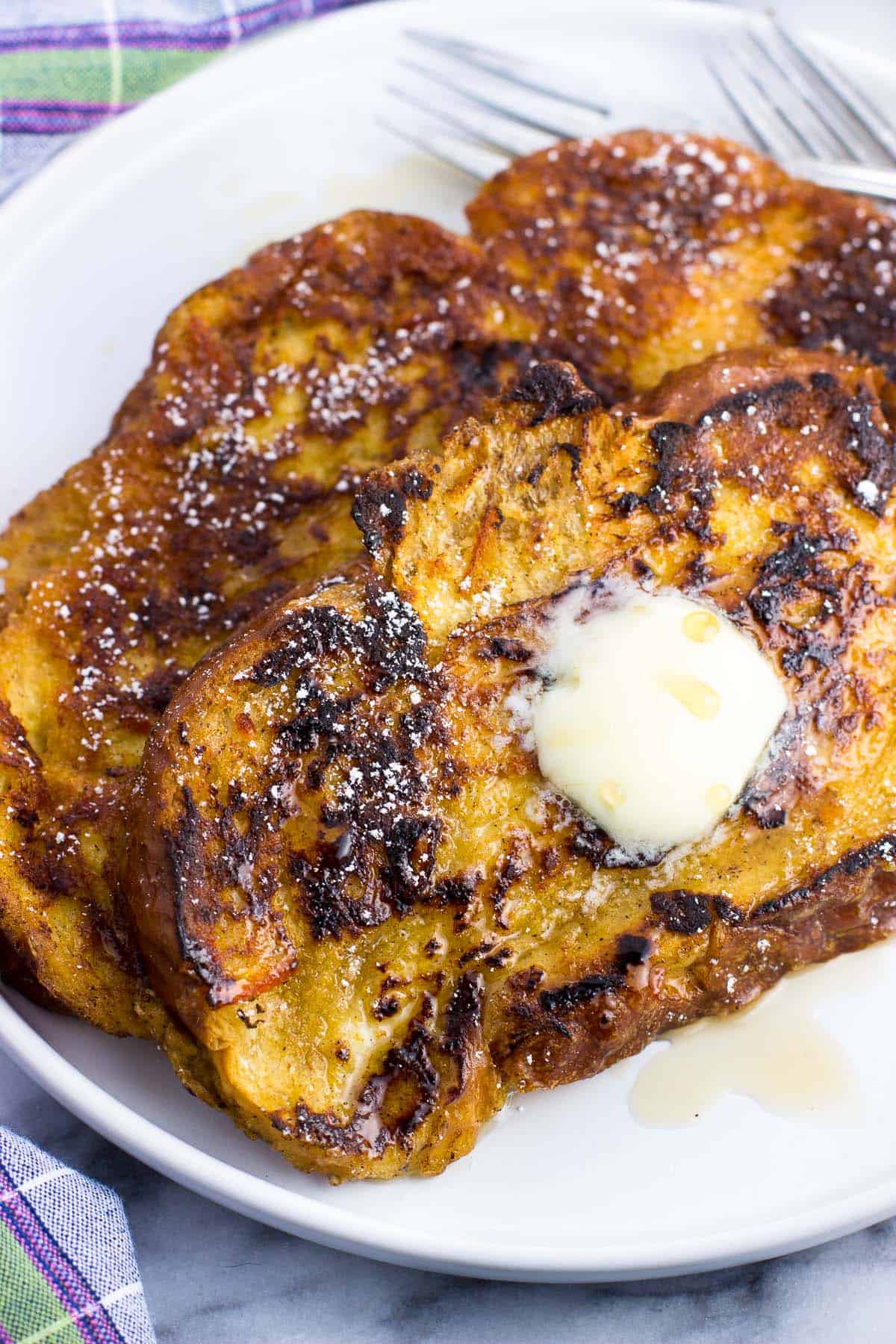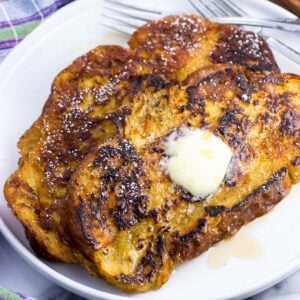Golden brown challah french toast is a big treat in the mornings. This rich, dense bread makes the BEST french toast and perfectly soaks up a spiced and slightly sweetened custard.

If I had to guess, four out of five times french toast is made in my house it's in the form of a bake. Tear the bread up, pour the ingredients in a pan, and bake. So easy.
While I can say that I prefer that way because it's more hands-off, the truth is that I think real deal french toast is kind of tricky to make!
You want to ensure that your bread is sliced to the ideal thickness, that the slices soak enough to saturate but not become soggy, and that they cook at just the right temperature and for the right amount of time that they turn golden-brown (and not burnt-brown) with a fully-cooked center.
And unless you're up for manning multiple large skillets at once, you'll likely have to cook it in batches, which runs at odds against french toast's preferred serving temperature of right-from-the-stovetop.
So, despite all that, why am I sharing a straight-up challah french toast recipe here, you might ask? Because when the right ingredients are chosen and certain tips and tricks are followed, the end result is WELL-worth the care involved.
Why This Recipe Works
- Unless I'm going festive (like in this panettone french toast bake -- YUM), challah bread is my top pick for making french toast. Because it's denser than regular sandwich bread, challah makes a fabulous choice for french toast. It absorbs the egg and milk well, all the while holding its shape nicely even while soaked.
- A hint of citrus, whether from orange marmalade, orange juice and/or zest adds a subtle but delicious flavor to a breakfast staple.
- This recipe post contains LOTS of tips and tricks for making not only optimal, less-stress challah french toast, but french toast at large.
Recipe Ingredients

Challah: A fairly rich, egg-based bread, challah is braided and baked into a fluffy, tender loaf. It has a fairly similar texture to brioche, though with a big difference. Challah is made dairy-free, as is important in the Jewish religion, while brioche is made with butter and milk. You can likely find a 16-ounce loaf of challah in the bakery section of a chain grocery store, as well as stand-alone bakeries.
Milk: There's wiggle room in the 1-¼ cup of milk. If you'd like a richer challah french toast, you can substitute in a portion of the milk for cream or half-and-half.
Orange marmalade: A hint of citrus flavor pairs wonderfully with everything else going on in the custard. Orange zest and a splash of orange juice will work, but I've taken to whisking two tablespoons or so of orange marmalade into the mixture. The little bits of preserved rind stick to the challah slices and add a very subtle flavor to tie it together (it isn't strong).
Vanilla extract: Any fans of Fiori di Sicilia? Its orange and vanilla taste fits right in here! Simply omit the orange marmalade and vanilla extract, using Fiori di Sicilia instead. I would add max one-half teaspoon of it as a little goes a long way.

Tips and Tricks
Paying mind to a few areas in prepping and cooking challah french toast ensures you achieve a golden and perfectly cooked end result.
#1 - Use stale bread. One- or two- (or three-...) day-old bread works best for french toast as the slightly stale nature helps it better absorb the custard.
#2 - Cut slices ¾-inch thick. One of the hallmarks of good french toast is a crisped exterior with a soft-but-not-squishy interior. Too thin challah slices can dry out while cooking and become tougher, while slices that are too thick may burn on the outside before the center gets a chance to cook sufficiently.
#3 - Don't soak too long. Aim to soak your slices for one to two minutes max per side, then get them out of there! You want the bread to be wet throughout, of course, but the challah will continue absorbing the custard as long as it's left in the mixture, which can lead to a super soggy slice.
#4 - Let the custard drip back in the dish. Lift out the soaked bread slices with a spatula (I actually use my fish spatula as it's slotted) and hold them over the dish with the custard for a few seconds before transferring them to the hot skillet to cook. This allows the excess egg mixture to fall back into the dish for future batches, and minimizes the amount that pools around the slices in the skillet.
#5 - Don't crowd the pan. You'll want to use your largest skillet/pan to make french toast, and even still it's likely that you'll need to cook in batches. Aim to cook as many slices as your pan will allow in a single layer on the bottom surface of the pan, with a bit of room between them so they're not touching. I always regret trying to sneak an extra slice in a batch, as the slices cook unevenly if they're squished in, raised up against the curve on the side of the pan, etc.
#6 - Keep an eye on the temperature. I've had many stovetops in my life, both gas and electric, and know that one stove's "medium" may not be the same as another's. It's a good starting point here, but be ready to adjust the heat lower if need be. Too-high of a temperature will result in an extra well-done exterior with an undercooked middle. The sweet spot for my current electric stovetop is more of a medium-low heat.

Reheating Instruction
While it's maybe not quite as good as freshly-cooked, leftover french toast slices can be refrigerated and then reheated, either in the microwave or in the oven. If going the oven route, use a low temperature and cover the baking dish with foil or a lid to prevent the french toast from drying out.
Recipe FAQs
Both eggy breads with similar textures, brioche tends to be richer as it's made with butter and milk. As is traditional, challah is dairy-free.
Yes, brioche can be substituted in this recipe for challah.
Classic french toast toppings include additional maple syrup, a pat of butter, fresh berries, and/or a dusting of powdered sugar. To round out a nice brunch, homemade breakfast sausage makes a protein-packed pairing.
Related Recipes
If you’ve enjoyed this recipe, I’d love for you to leave a star rating in the recipe card and/or a comment review below!

Challah French Toast
Ingredients
- 1 16-oz loaf slightly stale challah bread cut into ¾" slices
- 6 large eggs
- 1 ¼ cup milk
- 2 tablespoon maple syrup
- 2 tablespoon orange marmalade optional (see note)
- 1 teaspoon ground cinnamon
- ¾ teaspoon vanilla extract
- Pinch salt
To cook:
- 1 tablespoon butter
- 1 tablespoon neutral-tasting, high-heat oil such as vegetable or canola
To serve:
- Powdered sugar
- Maple syrup
- Butter
Instructions
- Cut challah loaf into ¾-inch thick slices.
- Add eggs, milk, maple syrup, orange marmalade (or zest/juice), cinnamon, vanilla extract, and pinch of salt to a large baking dish. Whisk to combine the ingredients evenly.
- Add butter and oil to a large skillet set over medium heat. Working in batches, add as many slices of challah that will fit in your skillet at once to the custard dish, letting them soak for 1-2 minutes per side. Once soaked, lift slices up with a spatula and hold them over the dish to allow excess custard to drip back in. Then transfer slices in a single layer to the hot skillet, leaving a little bit of space between slices.
- Cook for 2-3 minutes per side, or until the exterior is a deep golden-brown and has crisped up. Keep an eye on the temperature. If you notice the slices cooking a little fast, reduce the heat to medium-low.
- Continue for the remaining slices, adding additional butter/oil to the skillet between batches as needed. Serve warm with powdered sugar, maple syrup, butter, fruit, etc.
Notes
- Be sure not to leave the challah slices soaking for too long as this can lead to sogginess.
- Try not to cram challah slices into the pan when you're cooking them. Each slice needs room to cook evenly along the bottom of the pan.
- As written this recipe produces a fair amount of french toast slices. It can pretty easily be halved for a smaller crowd or if you'd prefer not to have leftovers.
Nutrition
Nutritional information is provided as an estimate. As it can vary due to many factors (brands used, quantities, etc.), we cannot guarantee its accuracy.
Food Safety and Nutrition DisclaimerP.S. Coming back to this challah french toast post from Pinterest or a saved link? You may recognize the photo below. I have updated this post (recipe, text, photos) in 2021 from its original publish date in October 2014.

Would you like to save this?
Plus receive periodic recipe newsletter emails.





Alyssa says
Thanks Chris! This is becoming a favorite weekend recipe for me for sure.
Alyssa says
Haha thanks Pamela! This makes weekend mornings extra special - I speak from experience. 🙂
Alyssa says
Thanks Jocelyn - I would love some right now too, even though it's just about my bedtime! 🙂
Alyssa says
Thanks Jess! I'm in the same boat as you I think! 🙂
Alyssa says
Haha wish I could ship you some, Anna! Thanks! And aren't moms great for texts like that (among many many other things)?
ATasteOfMadness says
This french toast looks amazing! I think I need to be making more French Toast instead of going for my regular oatmeal in the morning.
Alyssa says
I fully support sneaking in more french toast to your breakfasts! Although I do get in the oatmeal habit pretty frequently myself. Both are delish! 🙂
Marcie says
I used to make French toast and now I never do. I keep thinking about it lately, then this! This looks so good Alyssa, and I want some French toast this weekend!
Alyssa says
Thanks Marcie! I'm pretty much ready to eat french toast for breakfast, lunch, or dinner. No stale-ish bread is safe! 🙂